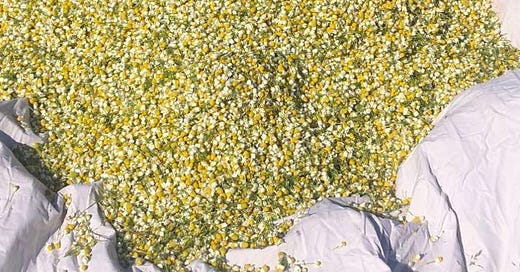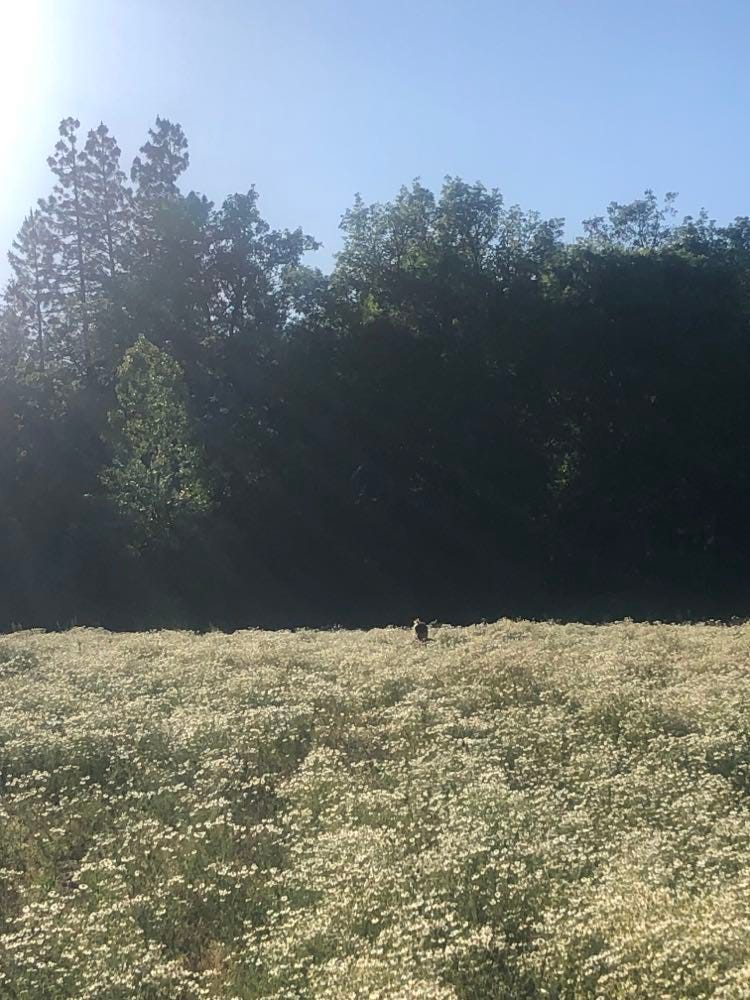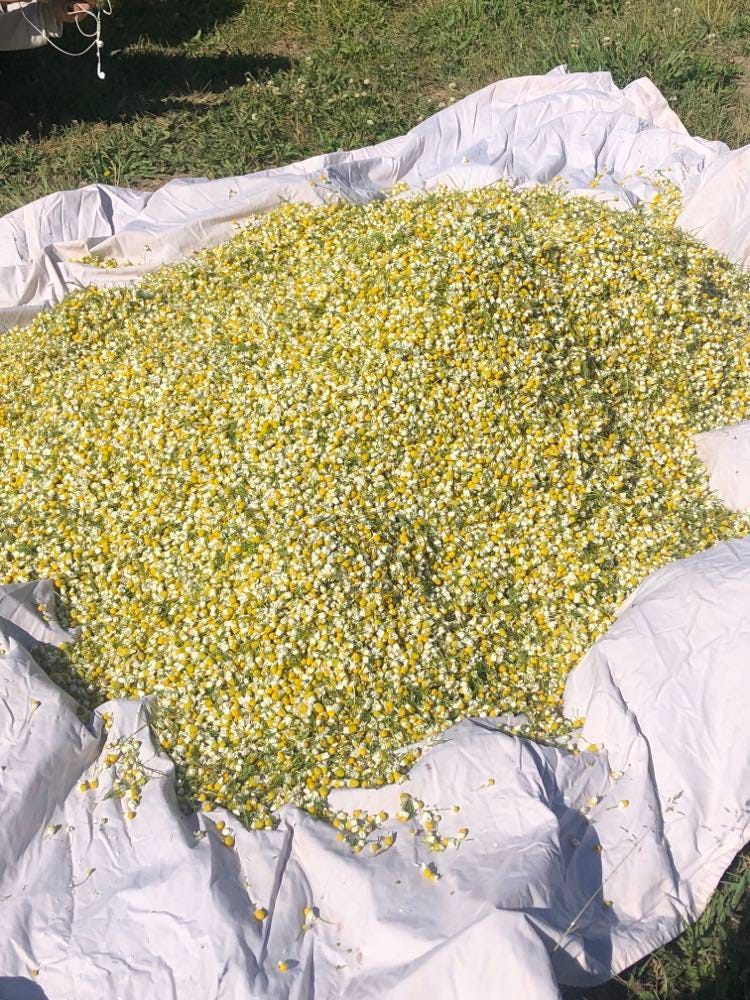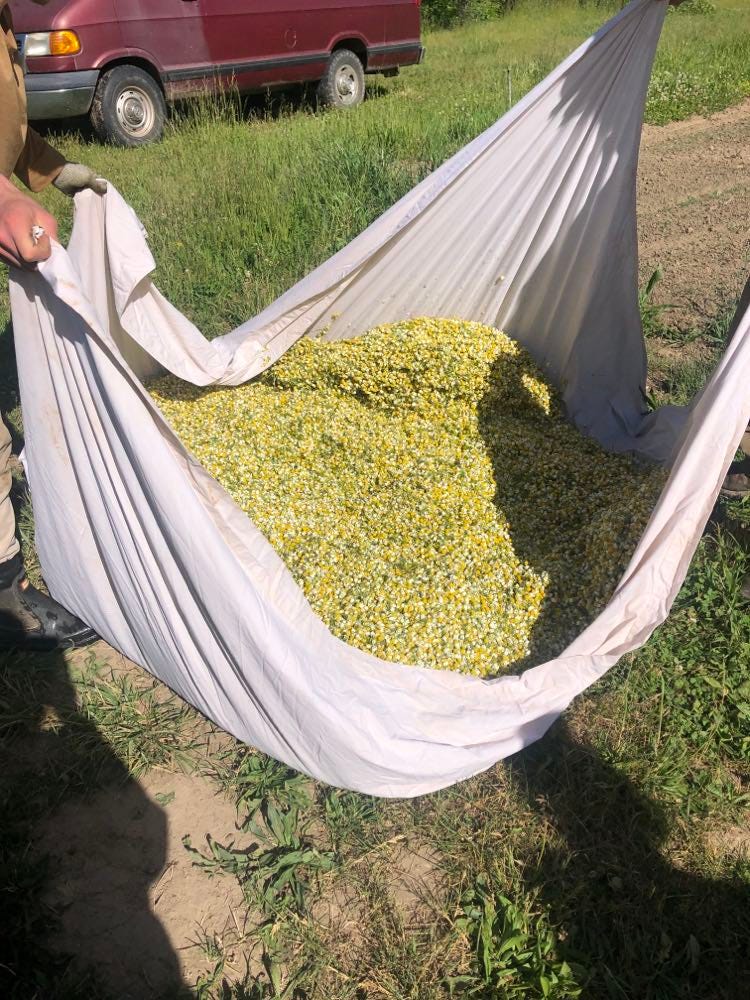This time last month I was in my final week of my Herb Pharm internship. I was overloaded with a multitude of feelings, from excitement for the unknown that would come afterwards, to grief for a chapter of life that was about to end. Trying to savour every fleeting moment there while also attempting to get my ducks in a row (eg. wrapping up the numerous medicine making projects I had on the go) was a lot. All the while, we were still working on the farm and not only that, doing the biggest harvest of our time there: chamomile.
Chamomile, a fitting herb to write about now so soon after the Summer solstice, is a plant ruled by the sun. Those sweet, delicate flowers almost look like little suns dotting the earth. The name, coming from Greek, means “earth apple”, potentially because the flowers have a somewhat apple-like scent. Who knows, but I think it’s cute! There are different types of Chamomile out there, and also different botanical names that I can’t quite keep straight. I’m writing about German Chamomile (Matricaria chamomilla or Matricaria recuitita), but basically all types can be used more or less the same. Although, I recently got introduced to a Roman chamomile plant and was taken aback by its candy-like scent. Reminded me of a candy you would get in one of those coin operated candy machines in a movie theatre in 2002, but in a good way. The name Matricaria comes from the latin “mater” meaning mother, or womb, and is so lovely to say out loud. Try for yourself to feel how it just rolls off the tongue.
The given name “little earth apple” makes me think of this Roger Miller song. It’s instantly soothing to the nerves, kinda like chamomile.
Last month while I was deep in the chamomile fields, I thought about how I’d like to write about the experience and then it dawned on me that I hadn’t even written a newsletter about chamomile yet (wtf??). I was seriously shocked as it is such a classic go-to herb for me. But that’s kinda the thing, chamomile is so often overlooked, or just put in the category of “sleepy time tea” and that’s it. Well, I am here to tell you it is so much more than that.
One of our teachers at my internship shared a Matthew Wood quote about chamomile, saying that it’s for “babies of all ages”. I sure get what he means! FES flower essences describe chamomile as being a remedy for irritable, moody people that are unable to release emotional tension. We’ve all been there, or at least I know I have. So chamomile is the perfect medicine for the cranky baby in all of us. Not only that, but it is awesome for nervous digestion. Digestive formulas typically combine bitter and carminative herbs, to help with bile production and to warm up and send blood to the stomach. The cool thing about chamomile is that it has both of those actions! It’s bitter but also a little warming. Last year when I was travelling Europe with just a carry on, I knew I could only realistically bring one tincture with me and I chose chamomile. It’s a panacea plant. Sleep, nervousness and anxiety, indigestion, PMS, cramping, it does it all. Chamomile is also a perfectly safe herb for babies and children (tea or glycerite) to help calm and soothe. Topically, a chamomile wash or poultice can be used to help heal wounds, rashes, and acne. Another beauty tip? Supposedly the vikings would use chamomile on their hair to lighten the shade of blonde. I might have to go back to my roots and try this hehe.
I read a fun lil anecdote in Scott Cunningham’s Magical Herbs book stating that “a hand wash of the infusion is sometimes used by gamblers to ensure winnings”. Worth a shot, right? Other folklore includes hanging the plant over doorways to ward off evil spirits. Seems like quite the lucky flower, and it even used to carry the nickname “plant’s physician” because people noticed that plants that were struggling would recover and thrive when moved near a chamomile plant. It’s a great addition to any garden and the pollinators love it.
Chamomile seems like a sweet, mild herb, but when brewed properly as a tea the taste can be pretty intense. Those delicate flowers are full of volatile oils, so it’s important to keep your tea covered as it steeps, so that those oils stay put. And not only that but steep it for a while. No more 3 minute tea bag steeps, people. If you want a medicinal chamomile tea you gotta let that puppy steep for at least half an hour and make sure that you’re using around 1 tbsp of dried chamomile per cup of water (that’s like 3-4 tea bags!). This ain’t your Twinings cup of chamomile tea.
During our big week of chamomile harvesting at the farm I realized that I am in fact allergic to the pollen, so that added a whole other element to the experience and made the days feel even longer. We used little hand rakes to essentially comb through the chamomile stems to pop off the flower heads, which looked easy enough, but doing that for 8 hours on end was something else. A few weeks before that, us interns were regularly going out into the chamomile field right by our house and just hand picking the flowers in a state of blissed out peacefulness. A far cry from the real world farm harvesting, but still beautiful either way.
From all of that hand picking, I came away with quite the chamomile haul for my own personal use. That includes a really nice chamomile glycerite that I made and have an abundance of. I thought it would be fun to do a little giveaway in this letter, SO anyone who shares this newsletter (you can click the “share” button below) from now until July 20th will be entered to win one 30ml bottle of chamomile glyercite (this one is a blend of glycerine and alcohol). *this is only open to those residing in North America due to shipping costs*. Share away and later this month I’ll be sending one of you your very own bottle of sweet, calming, chamomile goodness :)
Be well!
Anika











